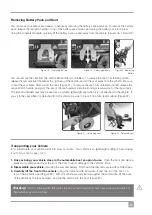
17
Control Through Doors
Approach an unfamiliar door slowly by sizing it up. Does it have a knob or a push bar? Does it open toward
you or away? Think in terms of using the power of the vehicle to do the work for you!
Hold the doorknob or bar in one hand and apply power with the other hand (Remember that you can drive for-
ward by using your left finger to move the throttle lever away from you). If the door is self-closing, you can go
through allowing the door to close behind you. If the door is not self-closing, just stop when you are clear of
the door, and push it closed. If the door opens towards you, hold the knob or bar with one hand, and gently let
the reverse power do the work. When the door is open wide enough, go ahead quickly, leaving the hand on
the door to keep it free of the vehicle and letting go as you pass the doorjamb. It is an easy technique. Practice
makes perfect. Remember, your vehicle can do the work without wearing you out!
Control on Ramps
More and more buildings are equipped with ramps for wheelchair access. Some have a change of direction in
the middle, and good steering skills are required. Make a wide maneuver with your front wheels around tight
corners, so that your back wheels follow in a wide arc to stay clear of the corner. If you stop while facing uphill,
the automatic parking brake will hold the vehicle from rolling backward. To start again, simply pull the forward
direction lever; the parking brake will be released, and you will start to move.
While going down the ramp, keep the speed dial set to “slow” (1/minimum). This will keep you in a safely con-
trolled descent. If you wish to stop completely, release the control lever, and you will slow to a gentle stop.
Control over Grass, Gravel and Inclines
Your scooter is designed for paved surfaces. You can also tackle smooth grass, packed gravel pathways and
gentle slopes, but
do not exceed the Maximum Safe Slope recorded in this manual.
If you are unsure
about a situation, avoid it. Packed gravel such as on driveways or roads will present few problems. Loose,
deep gravel should be avoided, as well as loosely packed sand.
DO NOT DRIVE THROUGH WATER OR LEAVE YOUR VEHICLE EXPOSED TO HEAVY RAIN.
Only attempt a turn when all wheels are on or off the pavement. Failure to observe this warning could result in
the vehicle becoming unstable and toppling over. Always lean forward when ascending kerbs. This will enable
you to climb easily and help eliminate instability.
PLEASE NOTE:
The rear stability of your vehicle is dependent on a number of factors which you should
consider before attempting to climb a steep slope or other obstacle:
• Your height
• The angle of your backrest
• Your weight
• The angle of the slope or height of obstacle you are attempting to climb.
• Position of your upper body
• The angle of the slope or height of obstacle you are attempting to climb.
• Position of your upper body weight (lean forward to prevent near tipovers)
All of these factors can affect the rear stability of your vehicle. If you are unsure of your capability to climb an
obstacle, always think “safety first”.
Warning!
Always lean forward when climbing up ramps or inclines to prevent accidentally tipping over
backwards.






























